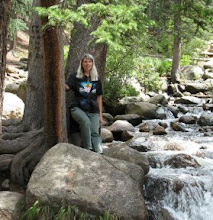My second summer in Colorado was spent entirely in another segment of alpine tundra, 10 solid weeks working above 12,000 ft (3,650 m) at Niwot Ridge, though living a couple thousand feet lower. One of those grand formative experiences available in youth, that summer left me with many fond memories and a new store of knowledge. But memories fade and knowledge grows dusty with disuse.
Last summer, visiting yet another chunk of alpine terrain, I discovered that the names of plants I'd been introduced to so long ago popped happily into my head, like old friends, when I saw them again. There they were: alpine avens and phlox, chiming bells and spring beauty, clovers and saxifrages and bistorts. And, yes, there were some who did need a fresh introduction, as acquaintances will when you meet them at class reunions decades later.
 Our first visit to Summit Lake Park on Mt. Evans in early July was at the height of spring. Most of the lake was still locked in ice. The entire growing season must fit into a short span of weeks, and, of course, it can snow or hail anytime. At 12,800 feet (3,900 m), it's a tough place to make a living.
Our first visit to Summit Lake Park on Mt. Evans in early July was at the height of spring. Most of the lake was still locked in ice. The entire growing season must fit into a short span of weeks, and, of course, it can snow or hail anytime. At 12,800 feet (3,900 m), it's a tough place to make a living. At the peak of summer, though, alpine tundra is lush, fascinating, and diverse. Among outcrops and loose boulders are meadows of wildflowers, grasses, and sedges. All are slow-growing and long-lived, unless they get munched by the few species of herbivores who are adapted to the area.
At the peak of summer, though, alpine tundra is lush, fascinating, and diverse. Among outcrops and loose boulders are meadows of wildflowers, grasses, and sedges. All are slow-growing and long-lived, unless they get munched by the few species of herbivores who are adapted to the area. Plants hug the ground: even shrubs like willows, tucked into protective spots, will be no more than an inch or two (3-5 cm) tall. Many of the wildflowers are cushion plants, others are tucked into crevices away from wind, as this Spring Beauty demonstrates. The interpretive sign reminds us not to trample them; they "grow by the inch, die by the foot." Only a few stomps off-trail can destroy decades of growth.
Plants hug the ground: even shrubs like willows, tucked into protective spots, will be no more than an inch or two (3-5 cm) tall. Many of the wildflowers are cushion plants, others are tucked into crevices away from wind, as this Spring Beauty demonstrates. The interpretive sign reminds us not to trample them; they "grow by the inch, die by the foot." Only a few stomps off-trail can destroy decades of growth. The largest mammals include these Rocky Mountain goats, "watchable wildlife" at this location. Visitors regularly marvel at their agility on the boulders and cliffs. Sometimes we might also see Elk or Bighorn Sheep, even here on the tundra. Yellow-bellied Marmots (much like the eastern Woodchuck) and the tiny Pika also scramble among the fellfields harvesting hay to store for the long winter.
The largest mammals include these Rocky Mountain goats, "watchable wildlife" at this location. Visitors regularly marvel at their agility on the boulders and cliffs. Sometimes we might also see Elk or Bighorn Sheep, even here on the tundra. Yellow-bellied Marmots (much like the eastern Woodchuck) and the tiny Pika also scramble among the fellfields harvesting hay to store for the long winter.Tomorrow I'll introduce some of these plant pals rediscovered last summer.
The Sequel: Wintry Wildflowers

No comments:
Post a Comment